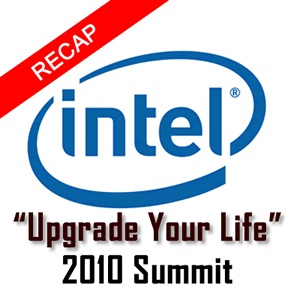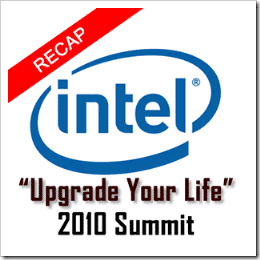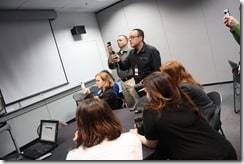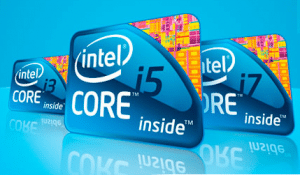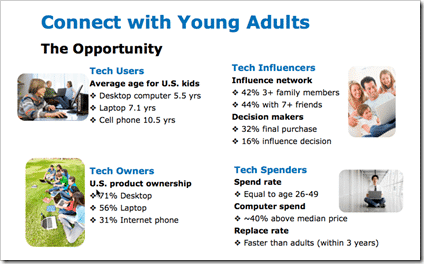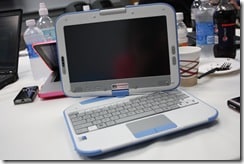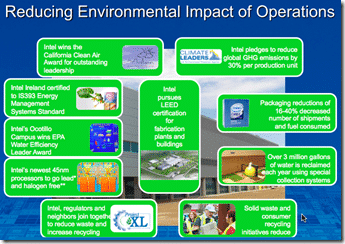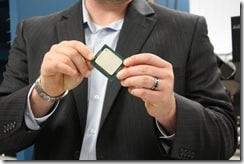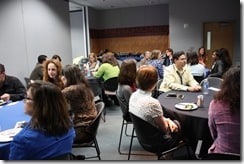A few weeks ago, I had the privilege of attending the Intel “Upgrade Your Life” 2010 Summit (my announcement) which was a gathering of a variety of technology influencers and bloggers. At this summit, we were introduced to a number of different individuals representing different initiatives within Intel.
There were 10 of us invited to participate in some very intimate discussions and conversation related to a variety of aspects of Intel. After the 10 hours of intensive meetings, my brain truly hurt from all of the information that I absorbed.
Attendees were:
- Alli Worthington of Blissfully Domestic – @AlliWorthington
- Amy Oztan of Selfish Mom – @selfishmom
- Asha Dornfest of Parent Hacks – @parenthacks
- Christina Tynan-Wood of Geek Girlfriends – @xtinatynanwood
- Beth Blechman of Tech Mamas – @techmama
- Helena Stone of ChipChick – @chip_chick
- Jeffrey Sass of Dadomatic – @sass
- Mia Kim of PopGadget – @miakim
- Michael Sheehan of HighTechDad – @hightechdad
- Suzanne Kantra of Techilicious – @SuzanneKantra
Some of the topics that were introduced included:
- Healthcare
- Education
- Entertainment
- Energy & Green Tech
- The Intel Labs
During the entire process, every attendee was sending out messages via Twitter tagged “#IntelUpgrade” so assuming that the inter-webs have accurately archived all of our tweets, you can see our Twitter live-stream there. It was practically impossible to do videos of each and every session, however, I did take a few videos and photos to document the process so that you can get a glimpse into what is happening at Intel, essentially, the “intel at Intel”. Before I go through a quick summary of the sessions, another attendee and fellow Cast of Dads member, Jeff Sass, (there were only two males in the group, by the way), recorded a quick video of our thoughts of the Summit:
Sessions
The sessions (and presenters) were as follows:
- Women in the Workplace: Old, New and Saying Adieu (Kim Warren, Intel’s Diversity Team)
- Intel Research & Social Science: A Healthier Tomorrow Starts Now (Eric Dishman & Ben Foss, Intel Digital Health)
- That’s Entertainment! (Genevieve Bell and Lance Koenders, Intel Digital Home; Mark Yarvis, Intel Labs)
- Improving Learning through Technology (Richard Beckwith, Intel Labs; Tony Salvador, Emerging Markets Platform Group)
- A Greener Intel (Lorie Wigle, Eco Tech Program Office; James Song, Intel Labs)
- Mad Science (Sean Koehl, Intel Labs)
Marketing Introduction
The Summit started out with an introduction by Heather Dixon (Consumer Marketing Manager at Intel) who outlined some of Intel’s marketing strategies and initiatives in the coming years. Heather presented some of the biggest challenges facing Intel currently, that of complexity and apathy. I must agree that over the years, the choices of consumer CPUs have become increasingly complex, even for me to understand. I mean with Core Duo, Core 2 Duo, Dual Core, etc, it was hard to know exactly what type of CPU the computer or laptop you were getting was.
Moving forward, Intel has dramatically simplified their consumer chipsets with three types:
- Core i3
- Core i5
- Core i7
The reasoning for the simplification was to minimize the confusion and complexity in the marketplace. Essentially, the higher the number, the more powerful the processor (e.g., good/better/best). You will see the new branding on many computers and laptops coming into the market now. They have been slowly phasing out the Centrino brand. The other processor that many users have seen is the Atom which is most commonly seen in netbook (but not laptops/desktops). The Atom will also be powering the new Smart TVs coming into the market.
Intel views “Young Adults” as the new opportunity (e.g., the “new consumers”). These Young Adults have never known the world without a computer or the Internet. For them, the cell/smartphone is just a form of breathing. Their tech ownership is higher than a typical adult as well and Intel is working at ways to better understand and reach that audience.
Women in the Workplace
This session, presented by Kim Warren, was really geared towards the “mommy bloggers” in our group and a bit less so towards the 2 guys (me and Jeff) in the bunch. The key points here were around diversity in the workplace and all of the efforts that Intel has been taking over many years at helping diversity and women in the Intel workplace.
As a side note on “diversity” (and I mentioned this already), both Jeff and I were encouraged by the fact that Intel DID diversify this Summit to include some males in the mix. I believe this is critical in order to form balanced opinions as well as the fact that male bloggers/daddy bloggers are rapidly rising up in the influence index.
Intel has developed programs and initiatives towards the promotion of diversity within their organization. In fact, as we walked through the HUGE areas of cubes where the Intel employees worked, I was truly impressed by the diversity, not just the ratio of males to females but also of cultures and races. Being from San Francisco, I see lots of diversity in my daily life, however, seeing an equivalent type of mixture within a large enterprise like Intel was great!
Intel Research & Social Science
This topic was really fascinating. I have mentioned the term “ethnographics” previously. Ethnographics is essentially “a qualitative research method often used in the social sciences, particularly in anthropology and in sociology. It is often employed for gathering empirical data on human societies/cultures” (Wikipedia). The important point here is that Intel is not just going out and wildly developing products without thought. They are actually spending time researching people and cultures and their interaction with technology. And these studies are not just a few days or a week, they go on for years and the researchers become quite intimate with their “subjects.”
In this particular session, both Eric Dishman and Ben Foss showcased how technology developed by Intel is being used to help promote independent living, chronic disease management and healthcare IT. Eric at one point stated “never accept the possibility that something is impossible.” This is a great line to live and learn by. Intel has been deep into researching Health related issues for over 10 years and working toward figuring out how tech can help improve the lives of those in need.
There were two gadgets that were shown to us/talked about during this sessions: the Intel Reader and the Intel Heath Guide. The Reader is a device that helps people who are vision impaired, illiterate or blind be able to function day to day. With the Reader, a user can take a snapshot of a written page and the Reader will read back the page in a natural speaking voice.
The user can follow along on a 4.3 inch screen where the text is greatly magnified. It is powered by an Intel Atom processor and is designed to keep people independent longer. It is designed to for a wide range of audiences from Students to Seniors, whether they have learning disabilities like dyslexia or are vision impaired.
The other device, the Intel Health Guide, was a fascinating device designed to help elders or those in need of persistent health check-ins remain a bit more independent as well. This device is networked to healthcare providers and family members and helps those remote members get regular health check-ins from those who health requires regular analysis and monitoring.
Typically paid for by an insurance company due to the cost, the Intel Health Guide acts as a daily diary and checklist related to a specific person’s health. It will ask that person a series of questions like “how are they feeling” and “did they take their medicine” as well as provide them assistance in their daily healthcare routine. Without being there, caregivers and family members have the ability to get remote diagnostics of patients and elders and know real-time how a patient is progressing or regressing.
I learned about some interesting ways that the Heath Guide was used with sensors around the house to effectively aid a sufferer of Alzheimer’s get through basic tasks that they may have forgotten. If the patient was in the kitchen and stood there for a long amount of time, not doing any action, they could be prompted automatically on how to do basic tasks around the kitchen, ones they may have forgotten.
Another interesting healthcare study (I cannot remember if it was hooked into the Intel Health Guide device or not) was that Intel Researchers were interested in learning how a person’s gait or walk might change day to day, so they installed walking pads that a person who has difficulty walk would stride across. The device would measure the touch points, the stride, the timing and a variety of other factors and could see if a person (e.g., doing therapy) was improving or not.
That’s Entertainment
This session was all about TVs, but not really in the way that you would expect. In this talk, Genevieve Bell, Director of User Experience, told us about the processes involved with understanding people’s interaction with TV. Some interesting points – the language used to describe one’s TV is that of “guilt-free indulgence” and that it is very different than other technologies in one’s life. She pointed out that things that we care about tremendously, like the TV, really haven’t changed or evolved that quickly.
Intel’s approached to innovation is cyclical: it begins with ethnographic search, moves to design and human factors engineering and then ends with iterative test visions where concepts and products are tested with consumers. The process then repeats until a product is fine-tuned enough to be deemed worthy.
Another interesting point that Intel discovered from careful observation and interviews of selected families around the globe was that everyone argues about the remote control, regardless of culture. TV becomes a shared set of experiences and stories. It does evolve but only on its own and as the consumer allows it. This is an interesting contrast to computers which evolve more quickly. While both have the same core function, more features are added to computers than TVs, that is, until recently. Now consumers want more and different content from different sources and TVs are quickly evolving to fill that need. They want simultaneous uses within the same footprint.
Intel has found that the new TV is already coming and it will be about having the choice of content and content sources and being able to control those choices and content.
Lance Koenders, Chief of Staff to S. Vice President/General Manager Intel Digital Home Group, made some interesting observations as well. He noted that all devices at CES (Consumer Electronic Show) 2010 all had Internet connectivity (e.g., DVD players & TVs) and that “Smart TV” is now a category, much the way we have moved from “dumb phone” to “feature phone” to now “smart phone”.
Because of technology advances in chip manufacturing, Intel is helping to revolutionize this Smart TV category but putting complete systems on a chip, Koenders explained to our group. Items that formerly utilized separate or dedicated components like video decoders have all been compressed down into a single silicon wafer, meaning that with a single chip, things that used to make up the bulk of TVs now are micro-sized. Expect more features and functionality coming from even smaller form factors.
Later, Mark Yarvis, Senior Research Scientist at Intel Labs, gave us a demo of a TV interface that they have been working on, unrelated to Google TV which was announced a few weeks ago at Google I/O conference.
Improved Learning Through Technology
The subject pretty much speaks for itself. I’m a firm believer in this concept. While there is something (obviously) to be said about physical, hands-on education and in my opinion, nothing will replace the teacher-student interaction, there are some definite core uses of technology in education that can benefit students, teachers and administrators. Preparing a “modern child” for the real world that is complete with every possible type of gadget or technology is critical to ensure their success within the modern workplace.
One such product that was shown was the Classmate PC which is a laptop/tablet designed for children and education:
I have spoken and written about how our kids are adapting and melding with technology almost faster than it is developed and updated. Intel believes this as well. In fact, they give $100M a year in charitable contributions and volunteer hours each year. That fact alone will help propel our youth forward. Computing within the schools MUST happen in my opinion.
There are quite a few innovations that were discussed in this session, including how Intel is developing project-based learning training for teachers. One interesting item that Richard Beckwith, of Intel Labs and Tony Salvador, of the Emerging Markets Platform Group, discussed was how they are building “intelligence” to help young learners help solve age old problems. An example of something they are working on is how through the use of cameras watching what a child is doing, a computer or device can provide “assistance” to a child working to solve addition problems or tangrams (spacial problem solving). This system would then be able to assist the child, without the help of the teacher, in solving these problems and then give feedback to the teacher later on students’ progress.
A Greener Intel
People nowadays simply assume that companies are going green in one way or another. Intel, as they are always under public scrutiny, has obviously chosen to lead the way in innovation here. Lorie Wigle, Eco Tech Program Office and James Song, of Intel Labs, each provided compelling examples of what Intel is doing to “be green.”
Some interesting facts from this presentation:
- Intel is working to double the number of PCs while cutting total energy consumption in half
- By 2014, want to have 2 billion PCs running at 1/2 the energy as current but with 17x the compute power
- Create compelling power management solutions for consumers to manage energy consumption
By far one of the most interesting sessions took place in the Intel Labs where we got an overview of a new project that is in the works that can help the average consumer better understand the power consumption within their own home. While currently you can do this, it is costly and time intensive to set up and monitor. What James showed us was built around the concept that all electronic devices have “energy fingerprints.” We were shown how plugging in a toaster, or lamp or hairdryer, can instantly be “recognized” on a computer as being plugged in and turned on. There was no need to use special plug adapters or modify the electrical infrastructure of one’s house to do so. It is all done automagically.
Unfortunately, this technology will not be commonplace within the US households for 5-15 years as it is still emerging technology. But I think the potential is amazing.
Mad Science
The final session was in another Lab, led by Intel Labs Technology Evangelist, Sean Kohl, that where chips were tested and developed. By the time this session rolled around, my head was full and spinning from data overload. This was sort of similar to what we saw in this Lab. Each year, Intel seems to release new versions of chips that can process more data, faster and more efficiently. We saw a test bench where a chip was being tested on how well its error correction was. Photos were being rendered and we saw how the picture displayed with and without error connections when the chip was over-clocked. With error connection, you could actually over-clock the chip quite a bit without it not being able to render the photo correctly.
Another chip that we were shown was of particular interest to me. It was essentially a “cloud on a chip.” I work as the Technology Evangelist for a Cloud Computing company (GoGrid.com) and we actually do quite a bit of work directly with Intel. They have provided us with the latest and greatest chipsets to power our cloud, namely the Nehalem and Westmere chips. However, what was explained to me in this session was how Intel is experimenting on putting entire racks of servers into a single chip.
What this means is that if racks of computers were set up using this new “cloud on a chip”, you could essentially pack an entire datacenter into just a few servers, saving energy and power in the process. While Sean explained that this chip is 3-5 years out (as many of the Labs works are), it really got me thinking about the possibility of how Cloud Computing could really grow in terms of power, ability and features when enabling-technology from Intel is provided.
Speed Dating Lunch
We also had a speed dating lunch where we sat at round tables and every 5-10 minutes, a different Intel employee would come and talk to us about whatever we wanted. I had a charming conversation with Wendy March, Senior Designer and Research Scientist for the People and Practices Research Group within Intel Labs. We talked all about the ideas of ethnographics and how studies are made within cultures. Actually, this process bleeds over into many of the other sessions as well.
Summing it up
I want to thank Intel for including me in this incredibly informative and well organized event. I honestly hadn’t expected to receive such a vast amount of information in such a short amount of time. Also, it was great to meet such a great bunch of smart technology influencers and bloggers in one room. I’m encouraged as well that Intel is looking beyond just “mommy bloggers” and is diversifying to include “daddy bloggers” as well. I sincerely hope that they will continue to expand this educational process to other groups and I definitely hope to be part of other sessions similar to these in the future.
And a special thank you to Alison Wesley (from Intel) and Christine Ngo (from Ogilvy PR) who did an incredible job pulling this event together.
Disclosure: In accordance to the FTC Guidelines and WOMMA Code of Ethics, I am disclosing that Intel Corporation has covered my travel, accommodations and costs related to my visit to Intel’s Oregon-based offices. Additionally, I have a material connection because I received a gift or sample of a product for consideration in preparing to write this content. I was/am not expected to return this item or gift after my review period. More information can be found in my About page as well as here.
HTD says: Intel is much more than a simple chip manufacturer. From their ethnographics studies to their forward-thinking Labs, they definitely are tapping in on a variety of global intellectual resources to move the company quickly into the future.
